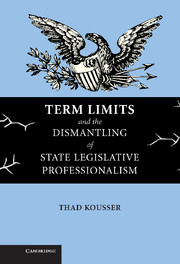Book contents
- Frontmatter
- Contents
- List of Figures and Tables
- Acknowledgments
- PART I THE MANY DESIGNS OF AMERICAN STATE LEGISLATURES
- PART II HOW DESIGN AFFECTS A LEGISLATURE'S FORM
- PART III HOW DESIGN AFFECTS A LEGISLATURE'S FUNCTION
- 6 Bargaining between the Legislative and Executive Branches
- 7 The Production of Policy Innovation
- 8 Conclusions
- 9 Epilogue: Adaptations to Term Limits
- Appendix to Chapter 3
- Appendix to Chapter 4
- Appendix to Chapter 5
- Appendix to Chapter 6
- Appendix to Chapter 7
- References
- Index
6 - Bargaining between the Legislative and Executive Branches
Published online by Cambridge University Press: 06 January 2010
- Frontmatter
- Contents
- List of Figures and Tables
- Acknowledgments
- PART I THE MANY DESIGNS OF AMERICAN STATE LEGISLATURES
- PART II HOW DESIGN AFFECTS A LEGISLATURE'S FORM
- PART III HOW DESIGN AFFECTS A LEGISLATURE'S FUNCTION
- 6 Bargaining between the Legislative and Executive Branches
- 7 The Production of Policy Innovation
- 8 Conclusions
- 9 Epilogue: Adaptations to Term Limits
- Appendix to Chapter 3
- Appendix to Chapter 4
- Appendix to Chapter 5
- Appendix to Chapter 6
- Appendix to Chapter 7
- References
- Index
Summary
One of a legislature's key powers is the ability to reshape policy proposals from the executive branch. This is in large part what separates a transformative legislature from an arena, and it often divides congressional from parliamentary systems. When a house lacks the capacity to scrutinize and amend executive proposals, its role in a system of separated powers is compromised. But if a state's legislature is transformative, it will be able to dissect the elements of a governor's offer, and – if it disagrees with them – rewrite the document to better reflect its own preferences. A useful way to evaluate a legislature, then, is by asking whether the influence of its members is equal to that of the executive branch in shaping policy.
Of course, a legislature may possess the capacity to alter executive requests but choose to exercise this power only when its members disagree with them. Why might the two democratically elected branches of state government be expected to have different policy preferences? A familiar argument references the legislature's reputation as the branch most responsive to the popular will. Jacob (1966, p. 5) tells us, “Every schoolboy has learned that legislators represent the people” and that “they are instrumental in integrating public demands with public policy.” It is true that an individual may have more access to his or her district's representative than to his or her governor and that members of one and sometimes both legislative chambers face more frequent elections than governors do.
- Type
- Chapter
- Information
- Publisher: Cambridge University PressPrint publication year: 2004



